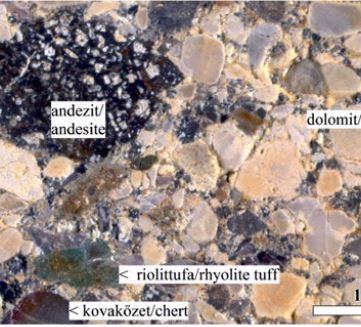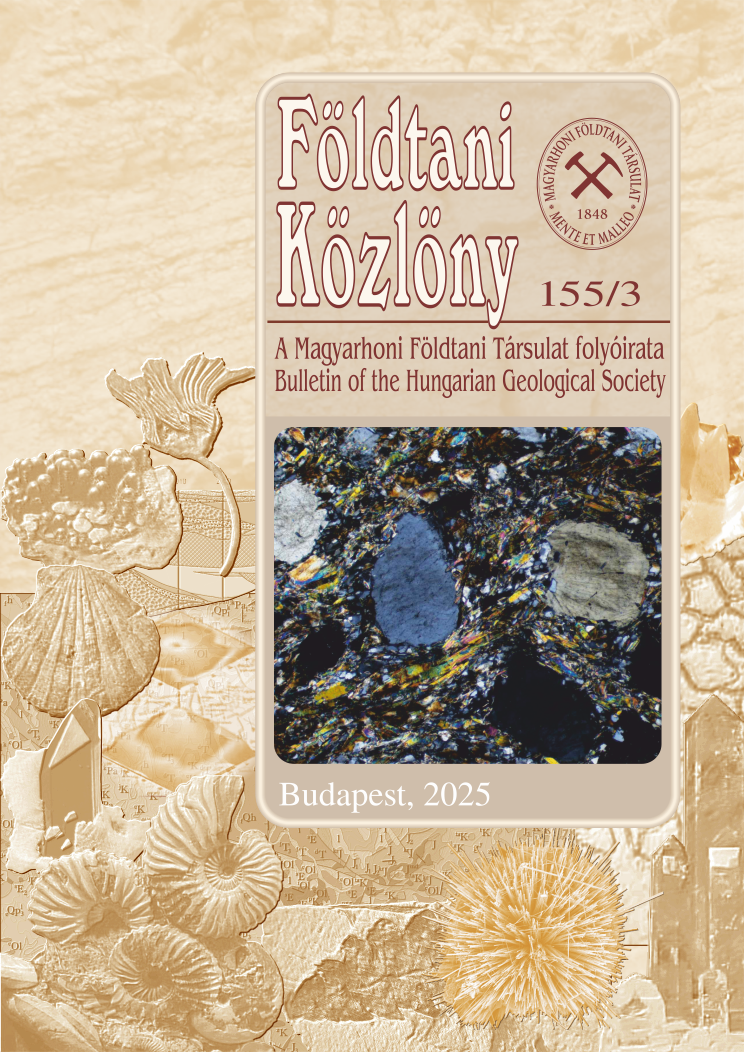Petrographic features of lava rock and tuff clast-bearing sedimentary rocks at the base of the Upper Eocene succession in the Buda Hills
Abstract
layers; these represent the basal part of the Eocene succession. This interval is followed by conglomerate and subordinately sandstone beds which contain clasts of various lithology and size. The dolomite clasts are the most abundant, but in some places the amount of lava rock and tuff clasts are significant, and chert, sandstone and tuffite clasts also occur subordinately. The main aim of this study is to review earlier studies on the volcanic clast-bearing Eocene basal beds, as well as to consider the results of petrographic investigations into the clasts, with special regard to those of volcanic origin.
The lava rock and tuff clasts are strongly weathered. However, on the basis of textural observations, the determination of the original rock-type was usually possible. Based on microscopic investigations, the following types of volcanic rocks were distinguished: (i) andesite (originally with a probably porphyric, pilotaxitic texture, and with pseudomorphs after plagioclase and pyroxene); (ii) amafitic andesite (with an originally trachytic texture and pseudomorphs after oriented plagioclase, and subordinate pseudomorphs after mafic minerals); (iii) intermediate lava rock (with a porphyric and pilotaxitic texture, and with pseudomorphs after feldspar and mafic minerals); (iv) dacite–rhyolite tuff (with juvenile glass shards and pumice; crystals: pseudomorphs after plagioclase, and subordinate quartz, pseudomorphs after pyroxene and biotite); (v) rhyolite tuff (juvenile pumice and glass shard; crystals: pseudomorphs after feldspar, quartz, and pseudomorphs after a pyroxene, biotite, accessory; lithic fragments: andesite, acidic lava rock, siltstone/sandstone, siltstone and chert); (vi) acidic lava rock (consisting of coarse-grained, dark-coloured, spherulitic and fine-grained, light-coloured, alternating bands). The dolomite clasts have a fabric destructive texture (finely-, medium-, and coarsely crystalline).
The lava rock and tuff clasts of the “Upper Eocene conglomerate” are derived from a calc-alkaline intermediateacidic volcanism. In order to determine the potential source areas of the conglomerate further comparative studies are needed. However, preliminary studies carried out by the authors of this study suggest that the Triassic andesite (which penetrates the Budaörs–1 well is petrographically similar to the andesite clasts found in the “Upper Eocene basal conglomerate”. Consequently, it appears that the investigated Eocene clastic deposits were probably formed via the reworking of previously deposited sediments containing clasts of Triassic volcanites. The tectonically altered pyroclastite (foliated cataclastite) occurs at the basalmost part of the Eocene succession; in a few sections its origins are probably associated with a simultaneous Late Eocene pyroclastic fall.












